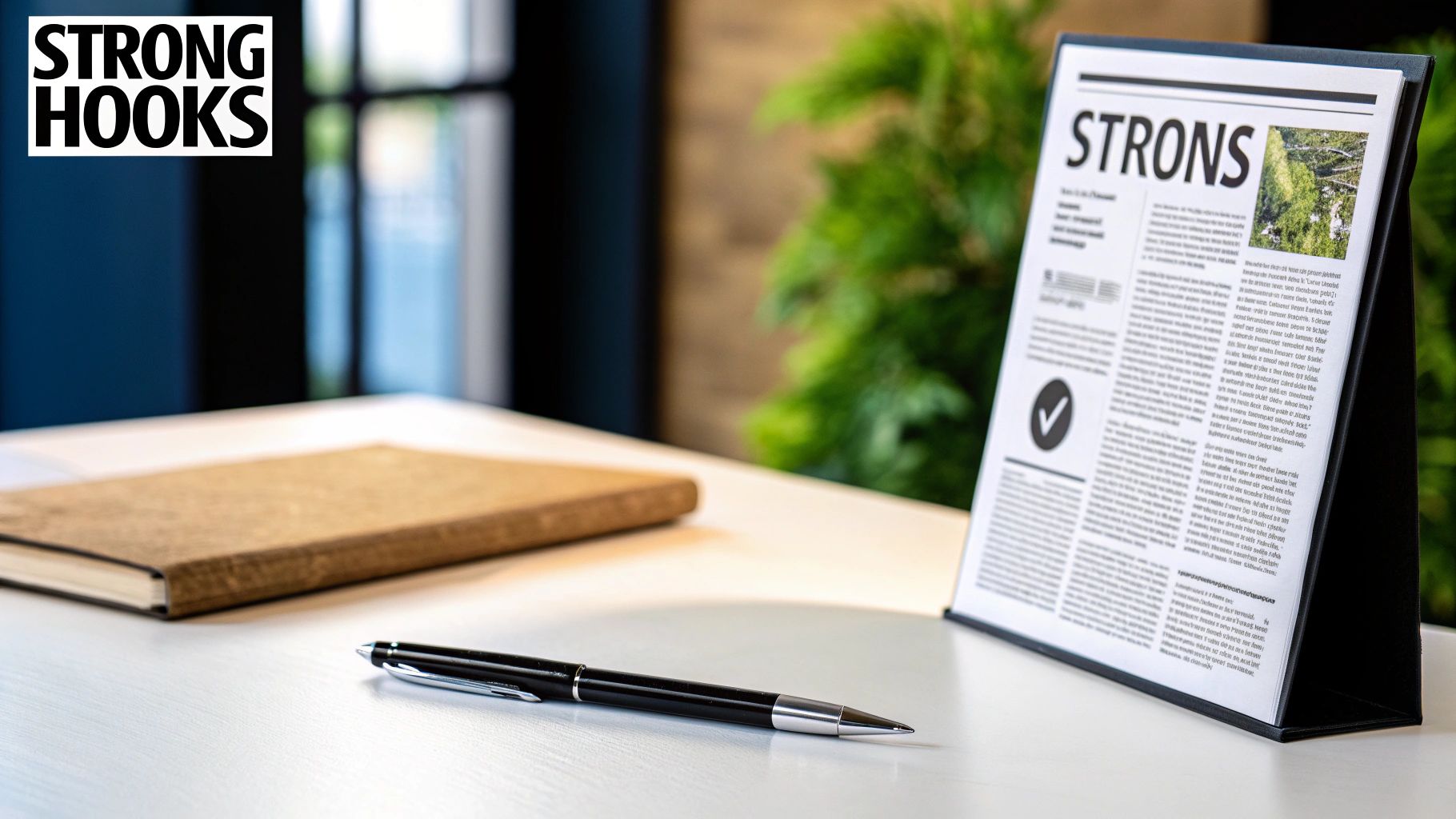
7 Essential Tips for Posting on LinkedIn in 2025
Published on 2025-07-06
In 2025, a strong professional brand is non-negotiable, and LinkedIn remains the premier platform for building it. However, simply sharing content is not enough to get noticed. The difference between a post that vanishes into the digital ether and one that sparks conversation, builds authority, and creates opportunities lies entirely in strategy. Effective posting on LinkedIn is both an art and a science, requiring a blend of authenticity, data-driven tactics, and genuine engagement.
This guide moves beyond generic advice to provide a clear, actionable roundup of seven powerful strategies designed for immediate implementation. We will skip the fluff and dive directly into the tactics that drive real-world results. Each tip is structured to help you not only capture attention in a crowded feed but also to build a meaningful, engaged community around your professional expertise.
From optimizing your schedule to writing hooks that stop the scroll, you will learn exactly how to refine your content approach. Get ready to transform your process, expand your network, and see measurable growth from your efforts on the platform. Let's begin.
1. Optimize Your Posting Time and Frequency
Timing is everything, especially when it comes to posting on LinkedIn. The platform's algorithm prioritizes fresh, engaging content, and your post's initial performance in the first hour can determine its overall reach. By strategically timing your posts, you ensure they go live when your target audience is most likely to be scrolling, commenting, and sharing.
This isn't just about avoiding posting at 3 AM. It’s about understanding the unique habits of your specific audience and industry. A B2B software company might see peak engagement mid-week during business hours, while a career coach could find success on a Sunday evening as professionals prepare for the week ahead. Consistency is the second half of this equation. Regularly posting on LinkedIn signals to the algorithm that you are an active and valuable contributor, which can lead to better visibility over time.
How to Implement This Strategy
To get the most out of your posting on LinkedIn, you need a data-driven approach rather than a "set it and forget it" mindset. Your goal is to find the sweet spot where your content meets the maximum number of active users.
- Analyze Your Data: Start with your native LinkedIn Analytics. Navigate to the “Analytics” tab on your company page or personal profile (if you have Creator Mode enabled) and look at the "Followers" section. This will show you the days and times your audience has been most active in the past.
- Test and Measure: Use your analytics as a starting point. Schedule posts at different times over a 2-3 week period. For example, test posting at 8 AM, 12 PM, and 4 PM on Tuesdays and Thursdays. Track the engagement metrics for each post to identify clear patterns.
- Consider Time Zones: If you have a global or national audience, don't forget about time zones. Schedule your most important posts to align with the peak hours for the largest segment of your audience.
Key Insight: The best time to post is not a universal rule; it's a personalized metric unique to your audience. Consistent testing and analysis are the only ways to discover what works for you.
By refining your schedule, you move from simply sharing content to strategically distributing it for maximum impact. If you want to dive deeper into specific timing recommendations, you can learn more about the best days and times to post on autoghostwriter.com. This methodical approach helps ensure your valuable insights don't get lost in the noise.
2. Create Value-Driven, Educational Content
The most successful content creators on LinkedIn understand a fundamental truth: the platform is a professional network, not a sales pitch forum. Users are actively seeking insights that can help them grow their careers, solve business problems, and stay informed about their industry. By consistently creating value-driven, educational content, you shift from being a seller to a trusted resource. This approach builds authority and fosters genuine connections.

This strategy involves generously sharing your expertise without an immediate expectation of return. Think of it as "teaching what you know." For example, a financial advisor could explain complex investment concepts in simple terms, or a tech leader could share actionable insights on digital transformation strategies. This type of posting on LinkedIn establishes credibility long before you ever ask for anything, making your network more receptive when you do have an offer. It’s about prioritizing giving over taking.
How to Implement This Strategy
Creating valuable content requires you to step into your audience's shoes and address their most pressing needs and questions. Your goal is to become the go-to person in your niche by consistently providing solutions and perspectives.
- Identify Audience Pain Points: Brainstorm the common challenges, questions, and frustrations your clients or colleagues face. What problem can you help them solve today? Use these pain points as the foundation for your content calendar.
- Share Actionable Takeaways: Don't just talk about a concept; show people how to apply it. Every post should include a clear, practical tip, a step-by-step guide, or a key lesson. For instance, a marketing expert could share specific data from a campaign and the lessons learned.
- Leverage Your Unique Experience: Use specific case studies, personal stories, and data from your own work. This makes your content authentic and impossible to replicate. Sharing a real-world example of how you overcame a challenge is far more compelling than generic advice.
Key Insight: Value is not about what you want to say; it’s about what your audience needs to hear. Focus on solving their problems, and you'll naturally build a loyal and engaged following.
By making education the core of your content strategy, you transform your LinkedIn profile into a hub of industry knowledge. This methodical approach to posting on LinkedIn ensures that your content not only gets seen but is genuinely appreciated and remembered, solidifying your status as a thought leader.
3. Leverage Visual Content and Native Video
In a feed dominated by text, visual content acts as a powerful pattern interrupt, stopping the scroll and drawing immediate attention. LinkedIn’s algorithm heavily favors visual media, particularly native video uploaded directly to the platform, which can generate significantly more engagement than text-only updates. When you incorporate visuals like images, infographics, carousels, and especially video into your strategy for posting on LinkedIn, you are tapping into a core element of how the platform prioritizes and distributes content.

The goal is to make your professional insights more digestible, memorable, and shareable. A well-designed infographic can summarize a complex report, while a behind-the-scenes video can humanize your brand in ways that text cannot. This approach, popularized by figures like Gary Vaynerchuk, transforms your profile from a simple resume into a dynamic, engaging media channel that builds community and authority.
How to Implement This Strategy
Successfully integrating visuals requires more than just attaching a stock photo. It’s about choosing the right format for the right message to maximize connection and retention. Your objective is to communicate value quickly and effectively.
- Prioritize Native Video: Always upload your video files directly to LinkedIn instead of sharing a YouTube or Vimeo link. LinkedIn keeps users on its platform by rewarding native content with greater reach. A short, impactful video can tell a powerful story, like a behind-the-scenes look at your company culture or a quick tutorial.
- Create Compelling Carousels: Use carousel posts (PDF documents) to break down complex topics into a series of digestible slides. This format encourages engagement as users must click to see the next slide, signaling interest to the algorithm. Use them to share step-by-step guides, lists of tips, or key takeaways from an event.
- Optimize for Silent Viewing: A majority of users watch videos on social media with the sound off. Add captions or burned-in text overlays to ensure your message is understood even without audio. This small step dramatically improves accessibility and watch time.
- Use High-Quality, Relevant Images: Ensure your images are crisp, well-lit, and properly formatted for the LinkedIn feed. Avoid generic stock photos and instead use authentic pictures of your team, products, or events to build trust.
Key Insight: Visual content isn't just a supplement; it's a strategic tool for communication. The best visuals don't just decorate your post, they deliver the core message in a more compelling format than text alone.
By making visual elements a cornerstone of your posting on LinkedIn, you cater to modern content consumption habits. This ensures your expertise not only gets seen but also gets remembered, driving deeper engagement and fostering stronger professional relationships.
4. Write Compelling Headlines and Hooks
On a platform crowded with content, the first line of your post is your most valuable real estate. A compelling headline or hook is the single most important factor determining whether someone stops scrolling to read your insights or simply moves on. This opening statement must grab attention immediately, create curiosity, and give users a compelling reason to click that crucial "...see more" link.

This isn't about clickbait; it's about accurately framing the value you're about to deliver. Think of it as the title of a book or the subject line of an important email. A powerful hook, popularized by creators like Justin Welsh and Sahil Bloom, sets the stage for the rest of your content. Whether you start with a shocking statistic, a vulnerable personal story, or a thought-provoking question, your goal is to make your audience feel they will miss out on valuable information if they don't engage.
How to Implement This Strategy
Crafting effective hooks is a skill that blends creativity with a deep understanding of your audience's pain points and interests. The objective is to stop the scroll and earn the click.
- Start with a Bold Statement: Open with a counterintuitive idea or a surprising result. For example, "This counterintuitive strategy increased our sales by 200%" or "I made a $50,000 mistake last year. Here’s what I learned..."
- Ask a Provocative Question: Engage the reader's mind directly by posing a question they feel compelled to answer. For instance, "What's the one question that changed your entire career trajectory?"
- Use Numbers and Lists: Numbered lists promise a structured, easy-to-digest format. A hook like, "3 things I wish I knew before starting my business" clearly sets expectations and creates intrigue.
- Test and Iterate: Don't stick to one style. Experiment with different types of hooks, from personal anecdotes to data-driven statements, and analyze which ones perform best. Track your posts to see what resonates most with your audience.
Key Insight: The first sentence of your post isn't just an introduction; it's a sales pitch for the content that follows. Its sole job is to convince the reader that the rest of the post is worth their time.
By mastering the art of the hook, you dramatically increase the chances that your valuable insights on posting on LinkedIn will be seen and appreciated. For more inspiration, you can find a variety of successful examples to learn from and see how top creators write great LinkedIn posts on autoghostwriter.com. This focus ensures your core message doesn't get buried.
5. Engage Authentically in Comments
The conversation doesn't end once you hit "post." In fact, that's just the beginning. Authentic engagement in the comments section, both on your own posts and on others' content, is a powerful and often overlooked aspect of posting on LinkedIn. The platform’s algorithm heavily favors posts that spark genuine conversation, meaning thoughtful replies and active discussions are direct signals that your content is valuable and relevant.
This strategy transforms your post from a one-way broadcast into a two-way dialogue. When you respond thoughtfully to every comment, you not only build stronger relationships with your audience but also significantly boost your post's visibility. The algorithm interprets this activity as a sign of high-quality engagement, pushing your content out to a wider network. This principle was foundational to LinkedIn's growth, with leaders like Reid Hoffman demonstrating how active community participation builds influence.
How to Implement This Strategy
To make your comment engagement meaningful and effective, you need a plan that goes beyond generic "thanks for sharing" replies. Your goal is to foster a community around your content and establish yourself as an active, helpful voice in your industry.
- Be Responsive and Timely: Aim to respond to comments within the first few hours of posting. Early engagement is a critical signal to the algorithm. When you reply, ask follow-up questions to encourage further discussion and keep the conversation going.
- Add Value in Your Replies: Don't just acknowledge a comment; build upon it. If someone shares an insight, thank them by name and add your own perspective or share a related resource. This shows you are genuinely listening and provides extra value.
- Engage on Other People's Posts: Dedicate time each day to meaningfully comment on 5-10 posts from others in your network or industry. This isn't about self-promotion but about contributing to the broader conversation, which increases your own visibility and establishes you as a thoughtful expert.
Key Insight: Comments are not a chore; they are an opportunity. Every reply deepens a relationship and tells the LinkedIn algorithm that your post is a hub of valuable conversation, extending its reach far beyond your initial network.
By treating the comments section as a core part of your content strategy, you harness one of the most effective organic growth levers on the platform. If you're looking for more ways to spark these conversations, you can discover additional tactics to boost your LinkedIn engagement on autoghostwriter.com. This proactive approach ensures your efforts in posting on LinkedIn yield the highest possible return.
6. Share Personal Stories and Experiences
People connect with people, not just with professional titles or company logos. Sharing personal stories humanizes your professional brand, creating a powerful emotional connection with your audience. LinkedIn users increasingly engage with authentic content that reveals real experiences, challenges, and lessons learned. This approach builds trust and relatability, transforming your profile from a simple resume into a platform for genuine influence.
This strategy isn't about oversharing or treating LinkedIn like a personal diary. It’s about strategically weaving your personal journey into your professional narrative. For instance, a story about a significant career pivot can teach resilience, while discussing the challenges of work-life balance can resonate deeply with other working parents. When done right, this form of posting on LinkedIn establishes you as a relatable and authentic expert in your field.
How to Implement This Strategy
To effectively share personal stories, you must find the right balance between vulnerability and professional relevance. The goal is to share a part of yourself that provides value to your audience, linking your experience to a broader professional insight.
- Connect Personal to Professional: Always anchor your story to a professional takeaway. If you share a story about a failure, conclude with the lessons learned and how they shaped your current success. For example, a project manager could discuss a failed project from early in their career and the risk-management strategies they developed because of it.
- Be Authentic but Selective: Share genuine experiences, but be mindful of professional boundaries. You don't need to share deeply private information. Focus on stories that illustrate growth, resilience, or a unique perspective relevant to your industry. A founder could share the initial struggles of securing funding, not to complain, but to inspire other entrepreneurs.
- Use a Storytelling Framework: Structure your post for maximum impact. Start with a hook that grabs attention, build the narrative with specific details, and end with a clear moral or a thought-provoking question for your audience. This encourages engagement and makes your story memorable.
Key Insight: The most powerful personal stories are not just about you; they are about the universal human experiences of challenge, growth, and learning. Frame your journey as a case study from which others can benefit.
By opening up and sharing your experiences, you invite your audience to see the person behind the profession. This vulnerability builds a stronger, more loyal community around your brand. To see how leaders like Brené Brown master this, you can explore her work on vulnerability in leadership on her website. This approach will significantly deepen the impact of your posting on LinkedIn.
7. Use Strategic Hashtags and Keywords
Think of hashtags and keywords as the signposts that guide LinkedIn’s algorithm and users to your content. Using them strategically helps your posts reach beyond your immediate network, showing up in relevant searches and topic feeds. When someone searches for a specific skill, industry, or topic, the right keywords and hashtags ensure your insightful content is part of the result, dramatically increasing its visibility.
This isn’t about stuffing your post with every trending tag. Effective hashtag use on LinkedIn is a nuanced practice. The platform's algorithm favors a small, highly relevant set of hashtags, typically 3 to 5, that accurately categorize your content. This focused approach helps LinkedIn understand who will find your post most valuable, connecting you with professionals actively seeking your expertise. Strategic keyword placement throughout your post text further boosts discoverability, making your content a valuable resource for your target audience.
How to Implement This Strategy
To turn hashtags and keywords into powerful discovery tools, you need a thoughtful approach that balances reach with relevance. The goal is to connect with the right audience, not just any audience.
- Research Relevant Hashtags: Before posting on LinkedIn, type a potential hashtag (e.g., #DigitalMarketing) into the LinkedIn search bar and select "Hashtags." This shows you how many followers it has. Aim for a mix: one broad hashtag with many followers (#Marketing), one more specific hashtag (#ContentMarketing), and one niche or branded hashtag (#YourCompanyCulture).
- Integrate Keywords Naturally: Identify the primary keywords your audience uses. If you're writing about AI in business, words like "artificial intelligence," "machine learning," and "business automation" should appear naturally in your post's main text, not just in the hashtags. This strengthens the post's relevance for both the algorithm and human readers.
- Monitor and Adjust: Track which hashtags deliver the most engagement for your posts. Check your post analytics to see which hashtags are driving impressions. If a particular tag consistently underperforms, swap it out for a new one in your next post.
Key Insight: The most effective hashtag strategy is not about broad reach alone, but about precision. A well-chosen niche hashtag can deliver more qualified leads and meaningful engagement than a generic, oversaturated one.
By carefully selecting your hashtags and weaving in relevant keywords, you make it easier for the right people to find your content. This intentional approach to posting on LinkedIn transforms your posts from simple updates into discoverable assets that attract your ideal audience.
7 Key LinkedIn Posting Strategies Comparison
| Strategy | Implementation Complexity 🔄 | Resource Requirements ⚡ | Expected Outcomes 📊 | Ideal Use Cases 💡 | Key Advantages ⭐ |
|---|---|---|---|---|---|
| Optimize Your Posting Time and Frequency | Moderate; requires analysis and scheduling | Low to moderate; scheduling tools recommended | Improved visibility and consistent engagement | B2B firms, career coaches, timely industry news | Maximizes reach and algorithm favorability |
| Create Value-Driven, Educational Content | High; demands research and expertise | High; time and knowledge intensive | Thought leadership, higher engagement, shares | Professionals sharing insights and tutorials | Builds trust and long-term audience loyalty |
| Leverage Visual Content and Native Video | High; needs video production skills | High; design tools and editing | Significantly higher engagement and shares | Brand storytelling, demos, behind-the-scenes | Stronger connections, 5x engagement potential |
| Write Compelling Headlines and Hooks | Moderate; creative skill needed | Low; content writing focus | Increased click-through and post engagement | Posts needing quick attention and engagement | Captures attention and boosts readability |
| Engage Authentically in Comments | High; time-consuming ongoing effort | Moderate; time investment | Enhanced relationships and post visibility | Community building and networking | Builds network trust and reciprocal engagement |
| Share Personal Stories and Experiences | Moderate; balance required | Moderate; thoughtful content creation | Emotional connection and higher engagement | Personal branding and relatable content | Creates authenticity and distinguishes content |
| Use Strategic Hashtags and Keywords | Low to moderate; requires research | Low; primarily research oriented | Better content discoverability and targeted reach | Posts aiming for wider reach and searchability | Improves visibility beyond immediate network |
From Strategy to Action: Your Next Move on LinkedIn
We’ve journeyed through seven powerful strategies designed to transform your approach to posting on LinkedIn. From the technical precision of optimizing your posting schedule to the human connection of sharing personal stories, each tip serves as a vital component in a larger machine. Mastering this machine doesn't happen overnight; it's a gradual process of building habits, analyzing results, and continuously refining your voice and message.
The true power of these insights is not just in understanding them, but in applying them with consistency. The most successful creators on the platform didn’t just post once and hope for the best. They built a system. They understood that effective content is a blend of art and science, combining authentic engagement with strategic use of hashtags, compelling headlines with value-driven education, and powerful visuals with genuine storytelling.
Unifying the Pillars of LinkedIn Success
Think of these seven strategies not as a checklist to be completed, but as interconnected pillars supporting your professional brand.
- Pillar 1: Visibility (Timing, Frequency, Hashtags): This is about ensuring your content reaches the right people at the right time. Without a solid foundation here, even the best content can go unseen.
- Pillar 2: Value (Educational Content, Visuals): This is your promise to the reader. You are committing to providing them with something worthwhile, whether it's a new skill, a fresh perspective, or a solution to their problem.
- Pillar 3: Voice (Personal Stories, Compelling Hooks, Authentic Engagement): This is what makes you unique. It’s how you turn a passive scroller into an active follower and a genuine connection. This is where trust is built and relationships are formed.
Your goal is to strengthen all three pillars simultaneously. A post with great visibility but no value will be ignored. A post with a powerful voice but poor visibility will never find its audience. When all three work in harmony, you create an undeniable presence that attracts opportunities and builds influence.
Your Actionable Roadmap Forward
To avoid feeling overwhelmed, don't try to implement everything at once. Instead, adopt a focused, incremental approach.
- Choose Your Focus: Select just one or two strategies from this article to master over the next two weeks. Perhaps you'll focus on writing stronger hooks or experimenting with native video.
- Commit to Consistency: Apply your chosen strategy to every post you make during this period. Don't waiver.
- Measure and Analyze: At the end of the two weeks, review your LinkedIn analytics. Did you see a lift in engagement, views, or comments? What worked and what didn't?
- Iterate and Expand: Based on your findings, refine your approach. Then, select another strategy from the list to incorporate into your routine, building upon your successes.
By following this simple cycle, you turn abstract advice into a concrete, repeatable system for growth. This deliberate practice is the secret to moving from sporadic, hit-or-miss posting on LinkedIn to becoming a confident, impactful voice in your industry.
Ready to streamline your content creation and maintain consistent, high-quality posting on LinkedIn without the burnout? The autoghostwriter platform helps you generate on-brand, engaging posts using AI-powered templates and a dedicated persona. Transform your content strategy and start building meaningful connections today at autoghostwriter.